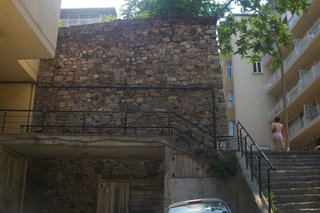
I have arrived in Istanbul with anticipation for the personal journey of exploration that the Rotch allows, but also with trepidation for accomplishing something contributory to the wider architectural discourse in my relatively short time here. After doing some preliminary research it is of course clear that myriad books and academics have already covered this incredible city more than I could ever dream of. So, personally, I must re-frame the goal of this travel from research to reconnaissance. Reconnaissance is a more appropriate term for the brief but intense periods of time spent in each of these locations, gathering information that will hopefully grant some insight into a niche that hasn’t already been covered, and that can be further explored on return trips (already thinking of coming back!) or back home academically. To that end, the results might be somewhat open-ended and less definitive. Likely, it will lead to more questions than answers. Ultimately, I hope there is a kernel of research that will be of interest to the community back in Boston
History here is king. The major monuments have incredible funds for cleaning, restoration and maintenance, and draw millions of visitors annually. This visitation directly contributes to a huge chunk of the municipal and national economy, buoyed by the fact that Turkey is relatively inexpensive for most visitors (though rapidly catching up with Europe). Houses in the older parts of the city go for a premium if they have a piece of a Roman wall or Ottoman staircase, which is not uncommon. In a city so layered with heritage, there is a realty market for history. Thus, Istanbul actually has a deep ethos of preserving their heritage, if only for speculation. The sheer volume of artifacts here means that almost every construction endeavor will unearth another piece of history. In many ways, it is easier to incorporate it than to destroy it. Most streets have an old wall or gate on it, often covered with weeds and with a pipe running through it. This accretion of tertiary artifacts gives the city an air of dilapidated energy when you step away from the shining monuments reserved for tourism. Multi family apartments step around a garden terrace that might be 50 or 500 years old, modern streets avoid crumbling wooden houses pinched between concrete buildings, and metal staircases are bolted to steps that might have led to an Ottoman medrese. Turkey, in contrast to the other cities on my itinerary, appears to possess the greatest desire for keeping the little bits of its past. This isn’t necessarily due to some unique affinity for history, but rather the economics of it all, since there is obvious incentive in the local market. While there are museums with great collections here, the city itself is the greatest compilation of antiquities, in situ and squeezed between cell phone shops and internet cafes.
A promising area of inquiry seems to be the Golden Horn, the river that splits Eminönü from Beyolu, historically an area of heavy marine industry. As the technology and needs of marine trade demand larger, deeper ports, former working waterfronts are being transformed for recreation and public consumption. It is a worldwide phenomenon and the Golden Horn is no different. The southern bank, Balat and Fener, is a very poor neighborhood mostly of immigrants from Eastern Turkey, separated from the Golden Horn by a traffic choked artery. It was part of the original Byzantium and the old city wall still runs along the river, with reclaimed land along the banks.
The northern bank on the other hand, Karaköy, is slated to become a model development for the New Istanbul, with mixed-use housing and cultural facilities. It is to be an exemplar of the progressive, international and optimistic Istanbul. No longer will the city be under the dusty blanket of the lost Ottoman empire; no longer will it be the city of hüzün (collective melancholy), as Orhan Pamuk writes. The New Istanbul will be one of culture, specifically a unique crossroads where the tired East/West dichotomy swirls together in hybrids that defy explication. These two very different but interconnected limnal zones have rich potential for further study. The pressure to develop the river and the thick layering of artifacts in the area creates an ideal zone of research.
Back in Boston I started with a number of interviews and will continue at the American Research Institute of Turkey and the Arkitera Center this week. I hope to uncover some of the urban analysis of the Golden Horn on a larger scale. Meanwhile, I will hit the pavement along each side of the river in search of more focused sites for architectural interventions.
Finally, as I sit here at the café drinking tea and listening to the sounds of backgammon dice and tavla pieces rattling around me, I wish to thank the Rotch Committee for this uniquely invigorating opportunity to explore the world and hopefully bring something back to the architectural community in Boston.
